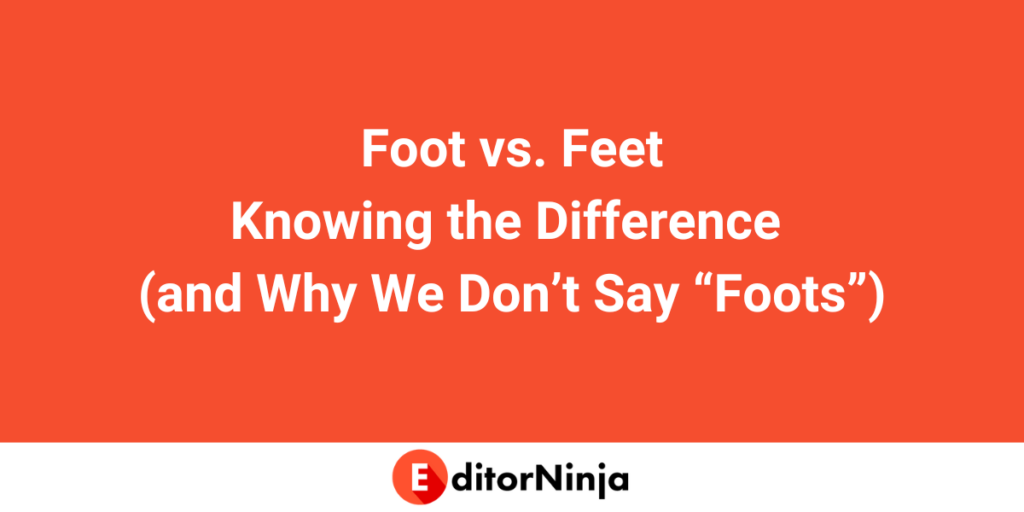Though in English we usually add the letter S to make words plural, in the case of foot, we don’t say “foots” — we say “feet.”
So, foot is singular and feet is plural.
That might be all you need to know, but if you’d like more information, keep reading. In this article, I’ll go more in-depth, providing definitions and examples — and I’ll explain why we don’t say “foots.”

The Definitions of Foot
Need a definition? I got you.
Foot has a few predominant meanings:
- A body part 👣 The foot is the body part at the bottom of the leg. It most commonly has ten toes and sometimes we put shoes on it.
- A measurement 📏 The word foot is also a unit of measurement in the imperial system, equalling twelve inches. There are three feet in one yard.
- The bottom or end of something ⬇️ Probably because we think of human feet as being at the end of our bodies, we’ve extended this meaning to non-human things. For example, “the foot of the mountain” is the base or bottom. Notes at the end of a page are called “footnotes.”
There are various other uses for this word, but these are the most common.
(As a Shakespearean, I feel obligated to mention that a “foot” is also a term used in poetry. It refers to a group of syllables, but that’s a pretty niche usage—perhaps a topic for another day!)
One Foot, Two Feet — Foot is Singular, Feet is Plural
Feet is simply the plural form of foot — for both meanings. So if you’re talking about only one, you say “foot.” If more than one, “feet.”
If you’re interested, you can read why below. But first, some examples!
Some Examples of Foot and Feet
First, let’s look at foot when it means a body part. Imagine a young couple is taking dance lessons:
“You stepped on my left foot,” one says. (singular)
“Well, you stepped on both of my feet,” the other retorts. (plural)
“You stepped on everyone’s feet!” the instructor chimes in. (plural)
And now, foot as a measurement:
Without glasses, Grandma can hardly see anything more than a foot from her face.
The pole is ten feet long.
As you can see, foot always becomes feet, whatever the meaning. Although…
Singular Foot in Compound Adjectives
While we never say “foots,” we do sometimes use the singular foot even when we’re talking about more than one. We do this when it’s part of a compound adjective describing a noun.
For example:
- a thirty-foot boat
- an eight-foot couch
- a hundred-foot building
In one of the earlier examples, we said “The pole is ten feet long.” We could also say:
It’s a ten-foot pole.
Similarly, we would say “a hundred-dollar watch” or “a four-layer cake,” not “a hundred-dollars watch” or “four-layers cake.”
Now You Have Your Footing
And that’s pretty much it!
Feet is the plural form of foot, and we use the singular form in compound adjectives—as in a phrase like “twenty-foot crocodile.”
Have more questions about the many confusing words in English? Check out our other articles, and tread the path of writing confidently.
Footnote: Why Don’t We Say Foots?
English has one dominant method of forming plurals: usually, we add -s to make something plural. But like many languages, English has a few other ways of forming plurals in addition to the predominant one.
Old English, the ancestor of modern English spoken about a thousand years ago, was much like its Germanic cousins in that it had lots of ways of making plurals. Adding -s was just one of them.
Sometimes the vowels in the word would shift (like tooth → teeth). Sometimes, different endings were added (like child → children). Yet as the language evolved, adding -s to make a word plural became more and more common, supplanting other methods — but a few stubborn words just stayed (more or less) the way they were.
Foot is one of those words — and it’s been pretty much the same for over a thousand years!
Need Help with Foot, Feet, and More?
EditorNinja is here to help! We’re a team of professional content editors, across line editing, copy editing, and proofreading. All EditorNinja editors are MFA trained and look forward to editing your written content!
Schedule a free editorial assessment today to see how using EditorNinja can save you days of time, buy back hours that you can use to create more content or work on other things, and make on average a 3.5x ROI, or at least $12,000+, on your investment.
